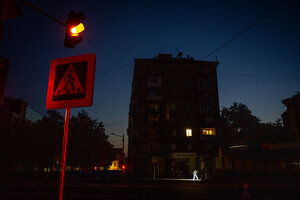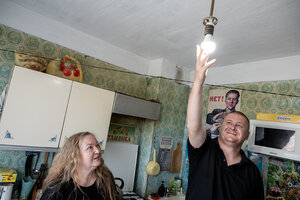With Russia targeting Ukraine’s power grid, ‘everyone is an electrician now’

A pedestrian uses the light of a mobile phone to walk on the sidewalk during a power outage, as Ukrainians grapple with severe power shortages caused by Russia's targeting of electrical infrastructure across the country, in Kharkiv, Ukraine, July 16, 2024.
Scott Peterson/Getty Images/The Christian Science Monitor
Balakliia and Kharkiv, Ukraine
Ukrainian welder Serhii Krasnokutskyi smiles as he points out the hooks already screwed into the frame of a southeast-facing window in his sixth-floor apartment.
That is where his small fold-up solar panel will hang – to absorb the most sunlight – if Russia’s sustained bombardment of Ukraine’s electricity infrastructure catches up with him.
But he and his mother, Antonina Krasnokutska, have been lucky: Their residential building in the eastern Ukrainian town of Balakliia sits along an electrical line deemed to be of critical importance.
Why We Wrote This
More than 30 months into the war, Ukraine’s life-sustaining power grid is still a prime target of Russian missiles and drones. And Ukrainians, from individual families to the officials in charge of keeping the lights on, are finding new ways to cope.
So even as most Ukrainians have been experiencing rolling blackouts – due to systematic Russian missile and drone attacks that have destroyed some 50% of Ukraine’s power-generating capacity – the mother and son have only recently started to lose power, too.
“I think the situation will only get worse; Russia has a lot of missiles,” says Mr. Krasnokutskyi. “Everything is related to electricity. … Even the air-raid sirens don’t work without it.”
Indeed, for Ukraine, keeping the lights on is a key war aim. And the accruing damage to Ukraine’s grid and the challenge it is presenting to the country is having political reverberations in President Volodymyr Zelenskyy’s government.
The head of Ukraine’s state electricity company Ukrenergo, Volodymyr Kudrytsky, was fired Monday, ostensibly for failing to ensure the sufficient defense of key installations – though media reports suggested political moves, even as a broad Cabinet shake-up got underway.
Many of Russia’s most recent waves of missile and drone attacks – conducted in apparent retaliation for Ukraine’s month-old incursion into Russia’s Kursk region – have focused on degrading Ukraine’s energy and civilian infrastructure.
A barrage of 100 missiles and 100 drones August 26, for example, which targeted electricity distribution substations across the country, required the imposition of emergency power outages “to protect the system,” said Maxim Timchenko, head of DTEK Group, the largest private investor in Ukraine’s energy sector.
“Ukraine’s Armed forces are actively engaged in defending DTEK power stations from incoming missiles,” he posted on the social platform X. Ukrainian officials have pleaded with Western allies for more air defense systems to minimize the impact of such attacks.
In June, President Zelenskyy said Russia’s spring targeting of Ukraine’s mammoth power stations and transmission capacity had already destroyed half the country’s power generation capacity – a strategic rate of destruction that continues to far outstrip Ukraine’s ability to make repairs.
A spring report by the Kyiv School of Economics estimated that Russia had destroyed more than $16 billion worth of energy infrastructure, including two key thermal power plants, and “critical damage of over 80%” to half a dozen others. The report put the cost to “build back better” at $50 billion.
“It’s just fear, sowing fear. … The [Russian] goal is to make life as difficult as possible,” says Oleksii Vishniakov, chief of the Balakliia Department of District Energy Networks.
“I consider it some kind of front line here,” says the no-nonsense, graying veteran of the electrical grid. “Those who work here overcome their discomfort, because they understand it is important to keep working, to keep the electricity on.”
Mr. Vishniakov and his team are racing to repair damaged electricity infrastructure across this district – when they have access to its 900 kilometers (560 miles) of high-voltage lines. The ground of some 530 kilometers of the lines was mined by invading Russian forces before they retreated in 2022, he says, and demining teams continue to work – and take casualties.
So far his team has replaced more than 325 electricity poles with new ones provided by the U.S. Agency for International Development – the new pole digger also comes from USAID – and deployed 160 U.S.-given electrical transmission units and miles of high-voltage cable.
Yet the schedule for electricity “depends on what in Moscow and the Kremlin they decide to hit today,” says Mr. Vishniakov. “As soon as they target something important again, that’s it, we have no electricity and cannot put together a predictable schedule. … Now we are living with the understanding that the situation can change at any moment.”
While Balakliia electricity is usually off just four hours a day, other areas in Ukraine can have as little as one hour a day.
The situation first changed here when invading Russian troops camped in Mr. Vishniakov’s district offices during their six-month occupation in 2022. They left the control room with its intricate, lit-up grid map destroyed, and the rooms wrecked. “I was crying,” the network chief recalls as he walks through the wreckage of his former office.
More recently, the vast Zmiivska thermal power station down the road was struck on March 22 with 18 missiles, knocking out power to the region.
“What I am doing with my crew, we need to prove that we are worthy of those people who are fighting on the front line, because they are fighting for each meter of our land,” Mr. Vishniakov says.
That front line is moving daily as Russia continues to make incremental advances along Ukraine’s eastern front – with a particular push now toward the city of Pokrovsk. Longer-range attacks with missiles and drones pose dangers to citizens and electrical grids alike.
“If you are between the zero line and 10 kilometers from the front, you must act like you are facing the Russians – something can come anytime,” says Colonel Yuri Povkh, military spokesperson for the Kharkiv region.
Balakliia may be 40 miles from the front line, but like a survivalist in his apartment, Mr. Krasnokutskyi is prepared. He has a number of battery power banks, surge protectors, and even a small generator hidden on his balcony.
When the Monitor first met this mother-and-son pair in September 2022, their electricity had just been restored after six months of Russian occupation.
“Electricity is civilization – it is everything,” Ms. Krasnokutska said back then, as they both marveled at the bulb hanging in their kitchen, which had lit up again for the first time just the day before.
The family got through that winter and the next, but now they echo Ukrainian officials in their worry about the strategic impact of Russia’s current campaign, as another ice-cold winter looms. Like many other Ukrainians, Mr. Krasnokutskyi is these days well-versed in the kilowatt requirements of home appliances – and how much he can provide with his 2.8 kilowatt generator.
“It’s a very common problem,” he says. “Everyone is an electrician now.”
Also doing similar math, but on a much larger scale, are Oleksii Yevsiukov and Viktoriia Varenikova, a husband-wife team who created and run the Avex company in Kharkiv, which produces swimming and fitness wear, and is now completely energy self-sufficient.
With a high-tech mix of solar and thermal power – and with the collected energy stored in a custom-fitted Tesla car battery the size of a closet – the company is providing a model for avoiding city blackouts and brownouts. The battery can hold two days’ worth of power if the solar panels do not produce enough.
Their plan to go green predates the Russian invasion. But the war – and its attendant energy uncertainty – was the catalyst to invest in the solar panels that line the workshop roof, and the piping of the geothermal unit in the basement that taps 70 yards deep into the earth to regulate temperature.
The factory worked for half a year with a diesel generator, but it was noisy, and required fuel and an engineer to keep it running. Fourteen staff now work here, producing some 2,000 high-end items for Ukrainian brands amid piles of material and walls covered with spools of thread in every color.
“We did one year of research before the war, then decided to do it,” says Mr. Yevsiukov, who uses excess power created by the solar panels to charge his electric car. “It is good for us, good for the nation, and for everyone.”
Oleksandr Naselenko supported reporting for this story.


